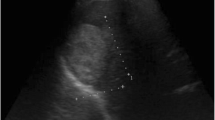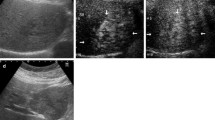Abstract
Hepatic sclerosed hemangioma is a rare benign liver tumor that originated from hepatic cavernous hemangioma; however, the process of its formation has been unclear. We herein present the patient of a histologically proven hepatic sclerosed hemangioma that showed drastic changes in diagnostic images in a short period. A 56-year-old man was referred to our hospital for the treatment of suspicious hepatocellular carcinoma with hepatitis C, approximately 2 cm in diameter in liver segment 8. Initially, the tumor manifested as early entire enhancement with mildly delayed washout in contrast-enhanced ultrasonography; however, it manifested as continuous peripheral enhancement with the central non-enhanced area after 1 month in various diagnostic images. He completely quit drinking and smoking 1 month preoperatively. No special symptoms and signs were found to suggest tumor ischemia. Anatomical resection of segment 8 was completed. Histological examination confirmed the final diagnosis of common type hepatic sclerosed hemangioma, derived from atypically enhancing cavernous hemangioma. No signs of impaired blood flow were observed in both diagnostic images and histological examination. Sclerosing changes in hepatic cavernous hemangioma may be completed in a relatively short time with no apparent reason.




Similar content being viewed by others
References
Berry CL. Solitary "necrotic nodule" of the liver: a probable pathogenesis. J Clin pathol. 1985;38:1278–80.
Cheng HC, Tsai SH, Chiang JH, et al. Hyalinized liver hemangioma mimicking malignant tumor at MR imaging. AJR Am J Roentgenol. 1995;165:1016–7.
Miyamoto S, Oshita A, Daimaru Y, et al. Hepatic Sclerosed Hemangioma: a case report and review of the literature. BMC Surg. 2015;15:45.
Choi YJ, Kim KW, Cha EY, et al. Case report. Sclerosing liver haemangioma with pericapillary smooth muscle proliferation: atypical CT and MR findings with pathological correlation. Br J Radiol. 2008;81:e162–e165165.
Miyata T, Beppu T, Kuramoto K, et al. Hepatic sclerosed hemangioma with special attention to diffusion-weighted magnetic resonance imaging. Surg Case Rep. 2018;4:3.
Ando Y, Ishigami M, Ishizu Y, et al. Utility of contrast-enhanced ultrasonography with perflubutane in evaluating indications for diagnostic percutaneous tumor biopsy in a case of hepatic sclerosed hemangioma. Clin J Gastroenterol. 2018;11:514–20.
Makhlouf HR, Ishak KG. Sclerosed hemangioma and sclerosing cavernous hemangioma of the liver: a comparative clinicopathologic and immunohistochemical study with emphasis on the role of mast cells in their histogenesis. Liver. 2002;22:70–8.
Huz JI, Melis M, Sarpel U. Spontaneous regression of hepatocellular carcinoma is most often associated with tumour hypoxia or a systemic inflammatory response. HPB (Oxford). 2012;14:500–5.
Takeda Y, Wakui N, Asai Y, et al. Spontaneous complete necrosis of hepatocellular carcinoma: a case report and review of the literature. Oncol Lett. 2015;9:1520–6.
Matsuoka S, Tamura A, Moriyama M, et al. Pathological evidence of the cause of spontaneous regression in a case of resected hepatocellular carcinoma. Intern Med. 2015;54:25–30.
Saito R, Amano H, Abe T, et al. Complete spontaneous necrosis of hepatocellular carcinoma confirmed on resection: a case report. Int J Surg Case Rep. 2016;22:70–4.
Sakamaki A, Kamimura K, Abe S, et al. Spontaneous regression of hepatocellular carcinoma: a mini-review. World J Gastroenterol. 2017;23:3797–804.
Kato H, Kanematsu M, Matsuo M, et al. Atypically enhancing hepatic cavernous hemangiomas: high-spatial-resolution gadolinium-enhanced triphasic dynamic gradient-recalled-echo imaging findings. Eur Radiol. 2001;11:2510–5.
Makamure J, Zhao D, Liu Y, et al. Hepatic hemangioma with arterioportal shunt: prevalence and lesion characteristics based on DSA, CT and MR imaging. Eur J Radiol. 2019;121:108715.
Shimada Y, Takahashi Y, Iguchi H, et al. A hepatic sclerosed hemangioma with significant morphological change over a period of 10 years: a case report. J Med Case Rep. 2013;7:139.
Yuki M, Emoto Y, Kinoshita Y, et al. Sclerosed hemangioma accompanied by multiple cavernous hemangiomas of the liver. Am J Case Rep. 2015;16:401–5.
Author information
Authors and Affiliations
Corresponding author
Ethics declarations
Conflict of interest
The authors declare that they have no conflict of interest.
Human and animal rights
All procedures followed have been performed in accordance with the ethical standards laid down in the 1964 Declaration of Helsinki and its later amendments.
Informed consent
Informed consent was obtained from all patients for being included in the study.
Additional information
Publisher's Note
Springer Nature remains neutral with regard to jurisdictional claims in published maps and institutional affiliations.
Rights and permissions
About this article
Cite this article
Akahoshi, S., Yamamura, K., Sato, N. et al. A hepatic sclerosed hemangioma with drastic changes in contrast-enhanced ultrasonography. Clin J Gastroenterol 13, 1252–1257 (2020). https://doi.org/10.1007/s12328-020-01194-5
Received:
Accepted:
Published:
Issue Date:
DOI: https://doi.org/10.1007/s12328-020-01194-5




